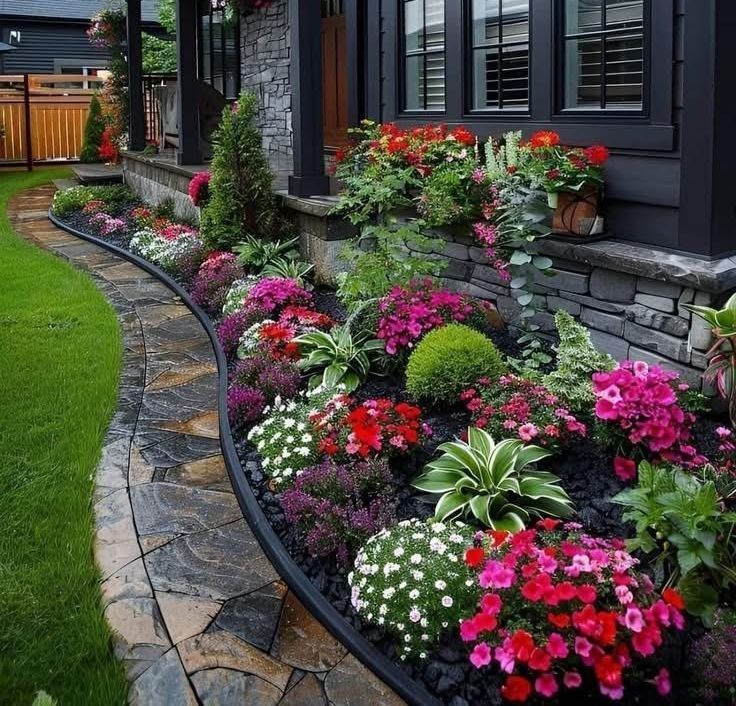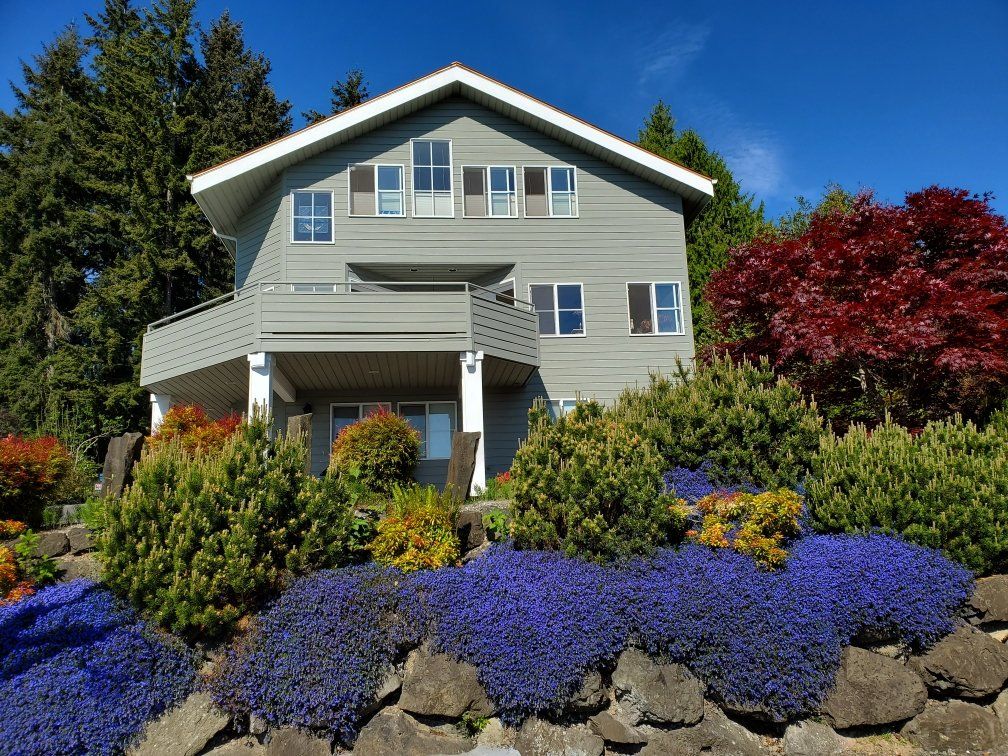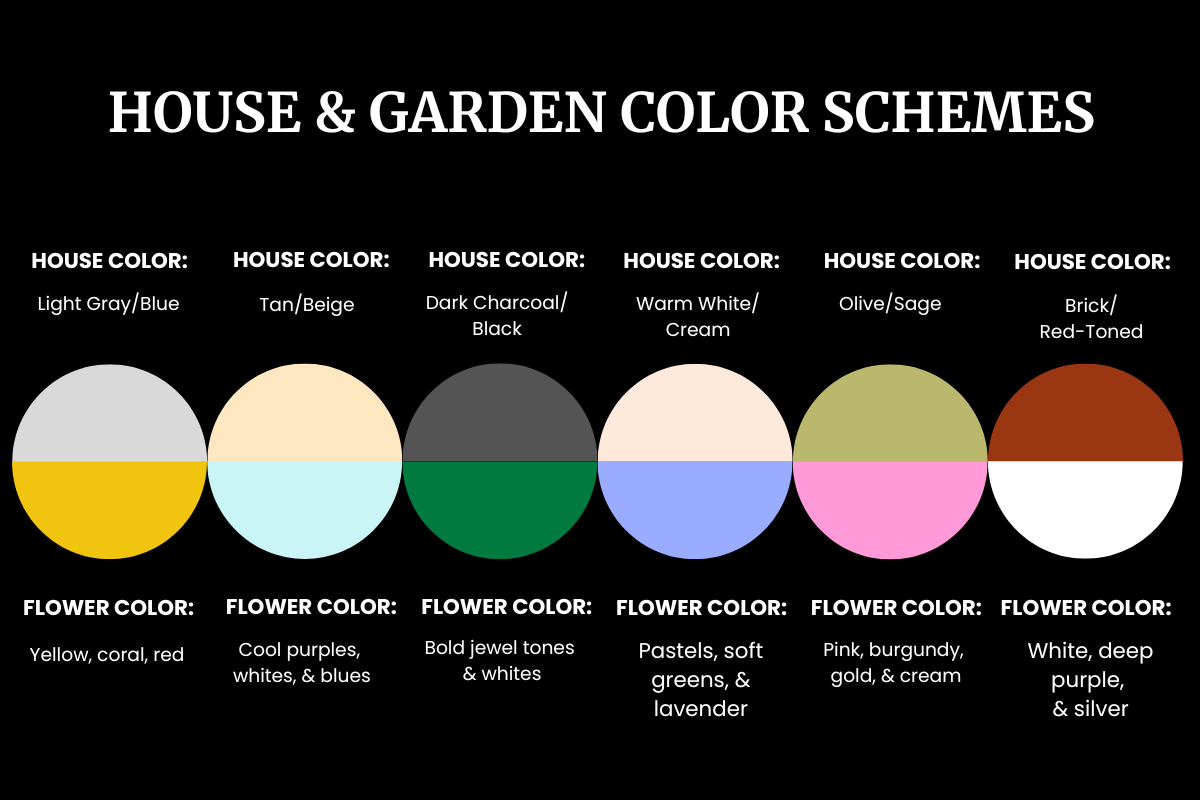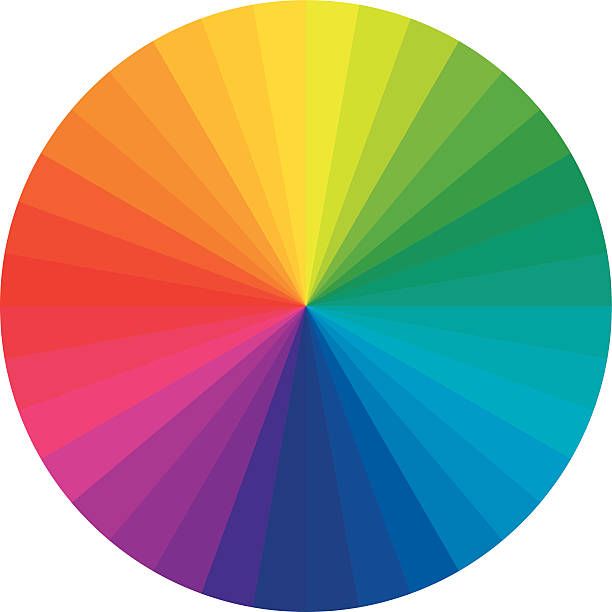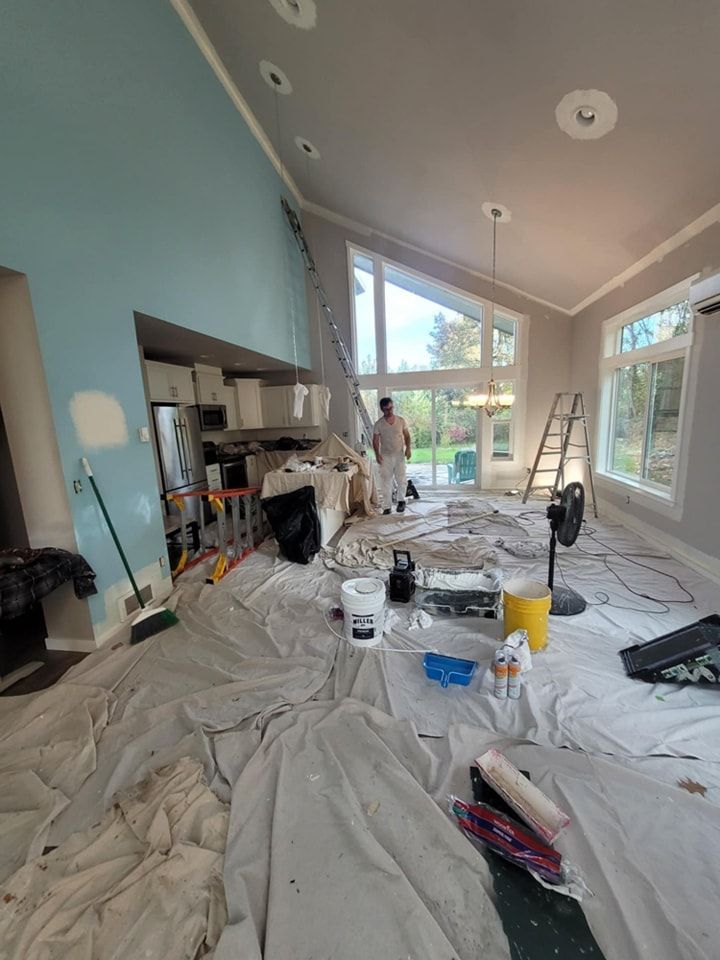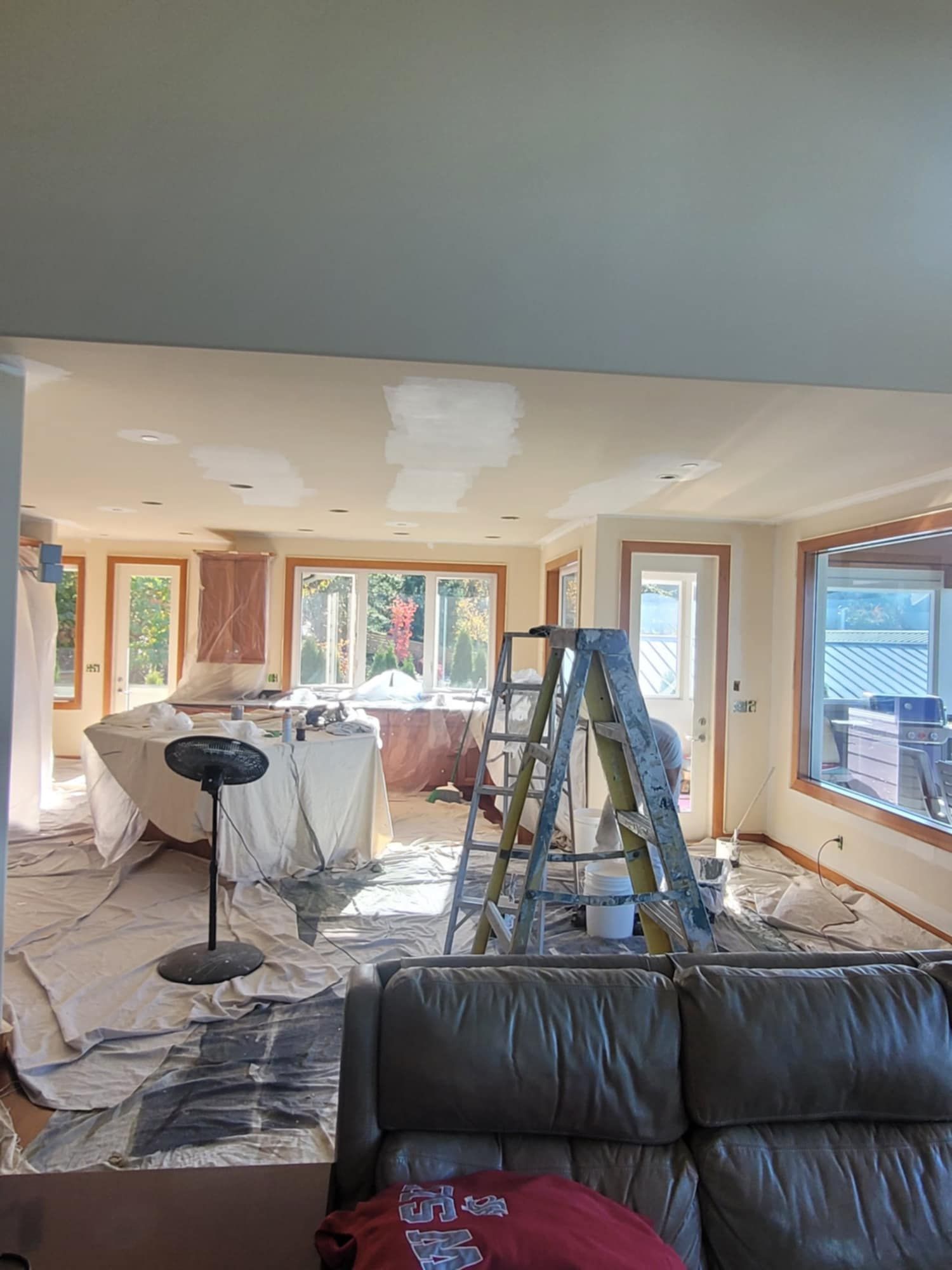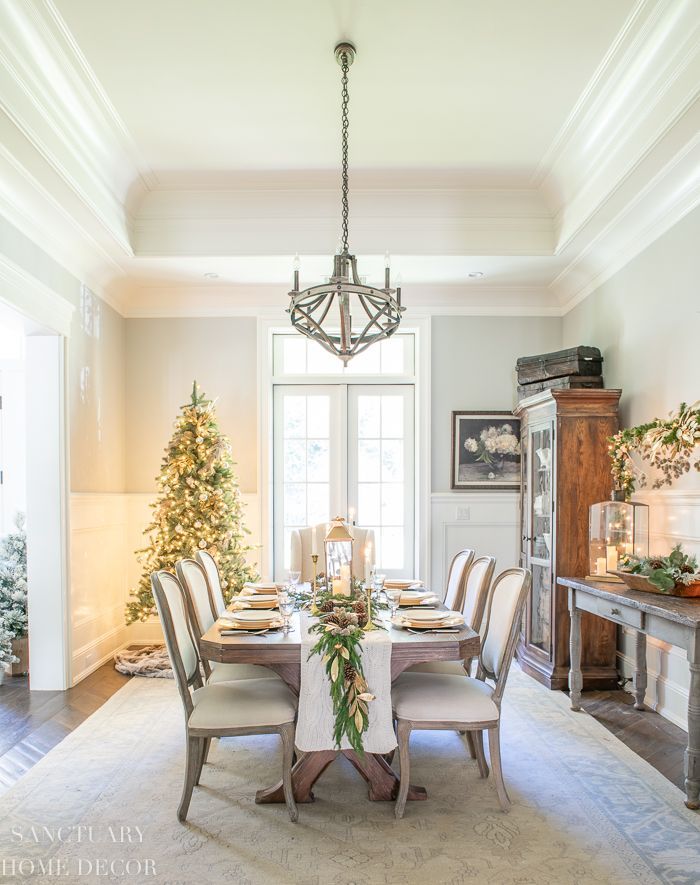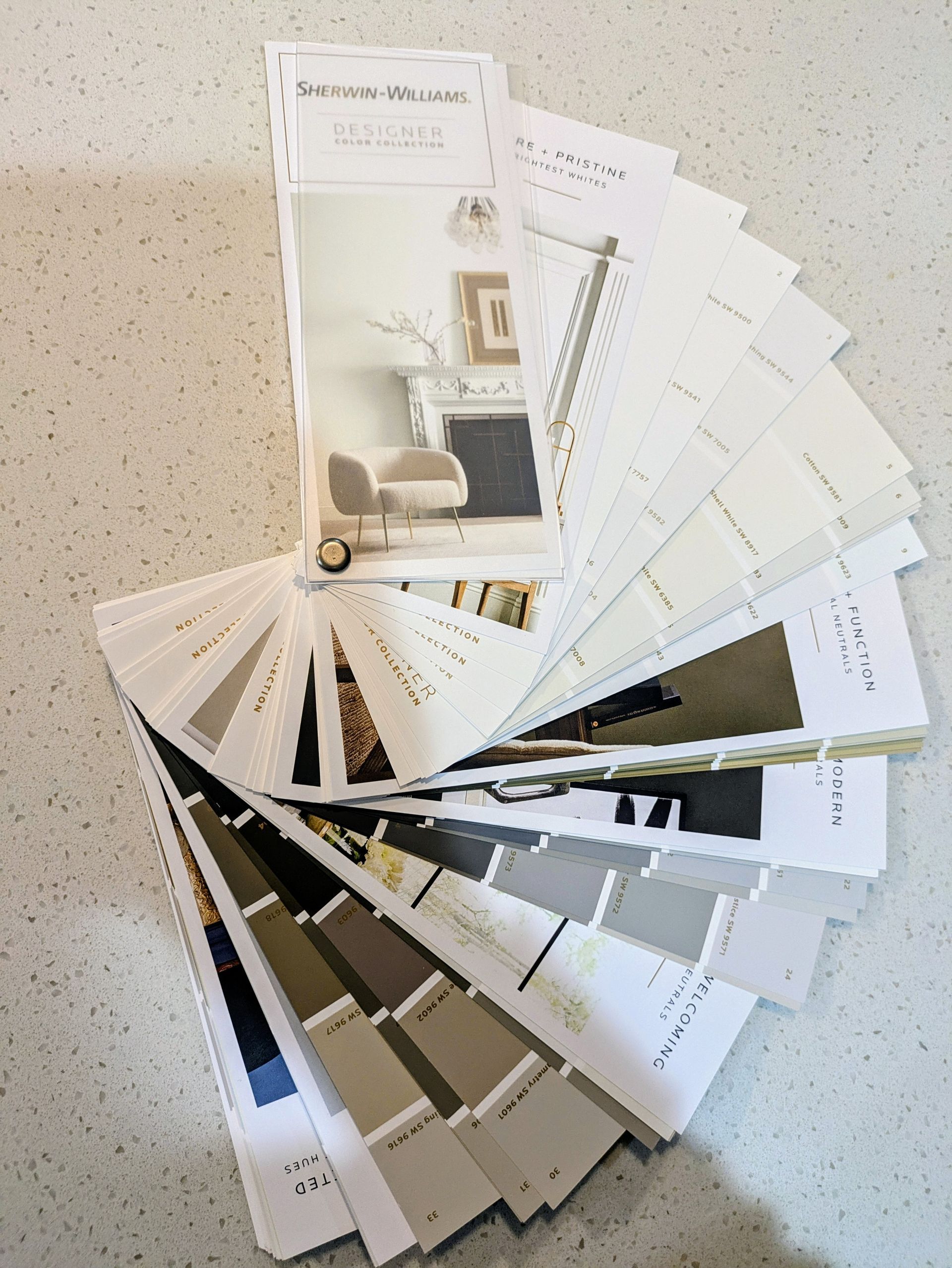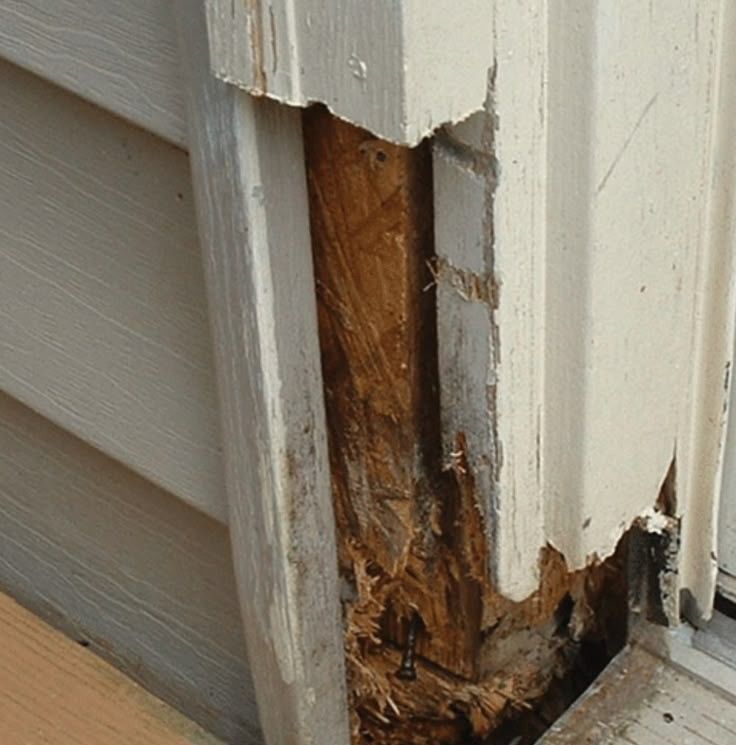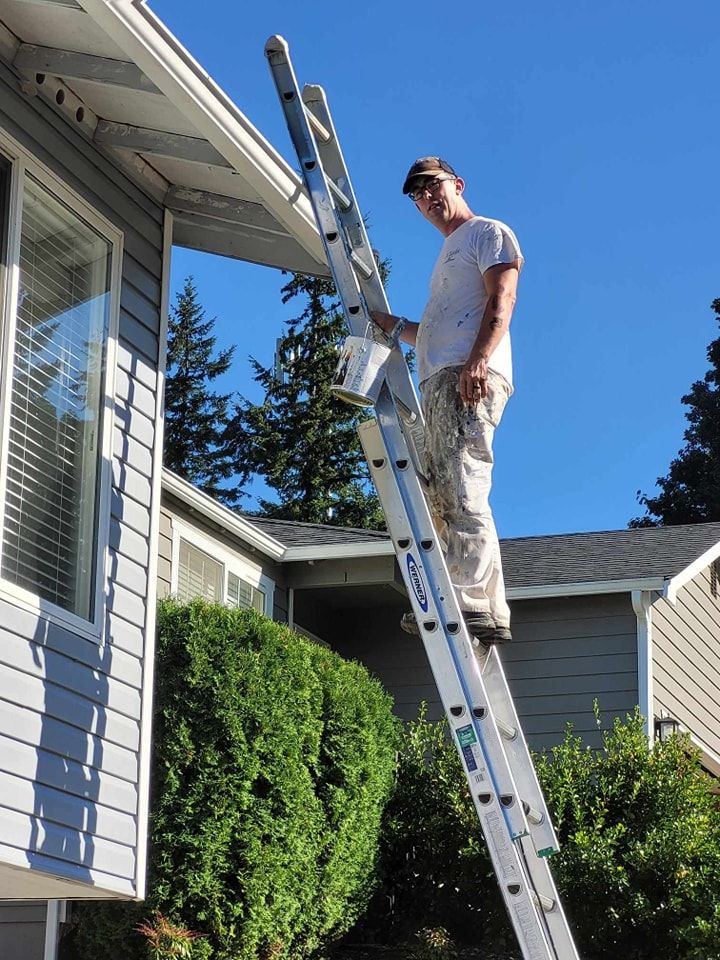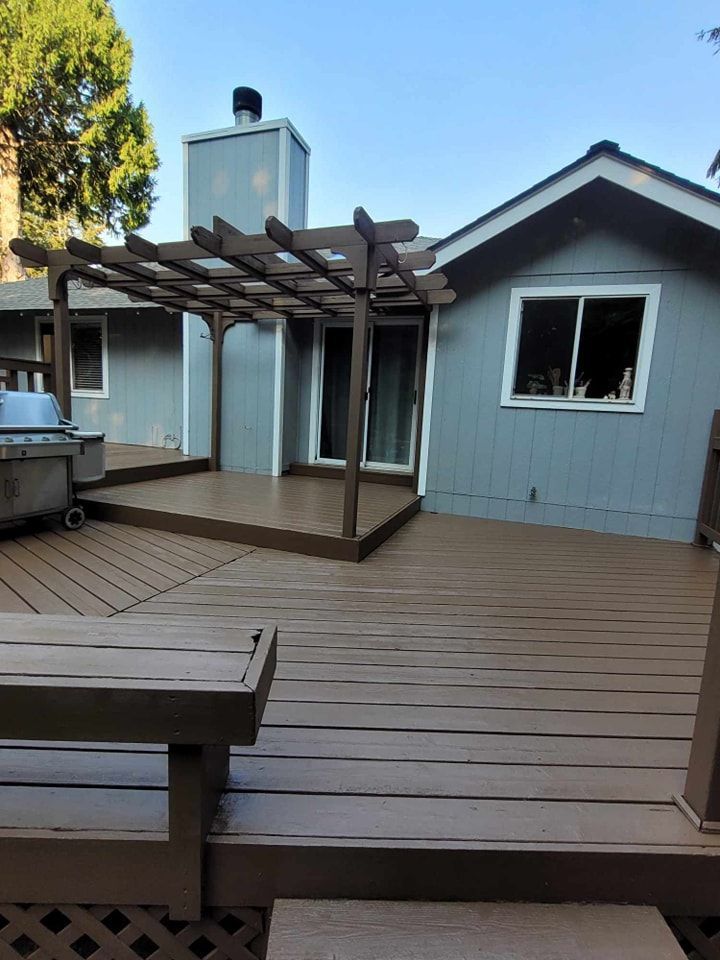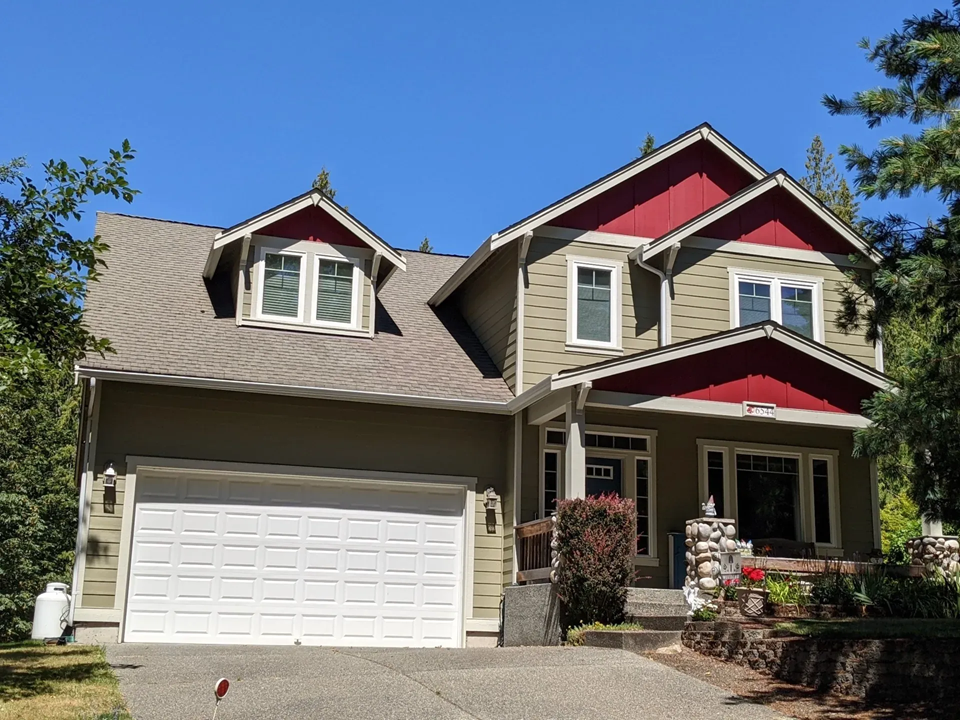A Fresh Look Starts with the Right Color
(and a Few Well-Placed Petunias)
If you're thinking about updating your home’s exterior—whether to boost curb appeal, prep for a sale, or just fall in love with your place again—paint and plants are two of the most powerful tools at your disposal. Together, they can completely transform the look and feel of your home without a full-scale renovation.
Here in Western Washington, where the skies are often gray and towering evergreens dominate, the right balance of color matters more than you might think. A smart combination of house color schemes and garden colors doesn’t just make your home stand out—it brings harmony, personality, and warmth to your entire property.
Color also plays a powerful role in how we experience a space. Cool tones like navy, sage, or slate can give your home a clean, peaceful vibe, while warmer hues like cream, russet, or olive create a cozy, grounded look. Paired with flower beds that complement or contrast your siding and trim, your exterior design can guide the eye, frame focal points, and add just the right amount of pop where it counts.
In this guide, we’ll walk you through how to coordinate your garden colors with your house color scheme—from plant pairing ideas and seasonal planning to paint tips and common mistakes to avoid. Whether you’re starting fresh or just looking to refine your curb appeal, we’ve got you covered.
How Paint Color Affects Your Landscape—
And Vice Versa
Regional Considerations: Gardening in Western Washington
Gardening in Western Washington is both a gift and a challenge. Our region's unique climate offers lush growing conditions, but it also comes with a few quirks that can influence everything from your garden colors to how well your plants and paint hold up year-round.
Moisture, Moss & Microclimates
Thanks to our wet springs and cool evenings, plants here grow fast—and so does moss. Shaded yards, overhanging trees, and minimal sun exposure (especially on the Key Peninsula or forested areas of Gig Harbor) can impact both your landscaping and your exterior paint job. That’s why it’s as important to choose plantings that can thrive in partial shade or tolerate damp soil as it is to opt for high-quality paint that resists mildew and fading.
If your home faces north or is tucked beneath heavy tree cover, aim for brighter garden colors like yellows, whites, and warm reds to visually “lift” darker corners of your yard. Homes with more sun exposure can handle deeper tones like purples, burgundies, or cool greens without getting lost in the landscape.
Soil Types and Drainage
Our local soil tends to be clay-heavy and slow-draining, especially in areas like Port Orchard and parts of South Kitsap. Raised beds, compost amendments, and smart plant selection can help avoid waterlogged roots. Plants like sedum, lavender, and ornamental grasses do well in drier pockets, while ferns, hostas, and hellebores thrive in the wetter, shadier zones.
Also, consider the slope of your property:
- If your home sits uphill or near a bluff, you might have fast-draining soil but wind exposure.
- Lower, flatter properties near creeks or wetlands will benefit from moisture-loving perennials.
Seasonal Shifts and Garden Planning
Flower Bed Design Tips That Pair with Your Home's Style
Not every house needs the same kind of flower bed. A tidy little bungalow will call for something different than a modern farmhouse or a wood-sided rambler tucked into the trees. When you’re thinking about how to coordinate your garden colors with your house color scheme, the shape and style of your home can help guide the overall design. Let's look at a few examples to get you thinking in the right direction:
Craftsman & Bungalow Homes
These homes often have wide porches, low-pitched roofs, and lots of charming trim details. To keep things feeling warm and welcoming, try layered flower beds with a mix of perennials and flowering shrubs. Consider planting phlox, black-eyed Susans, ninebark, or coral bells to add color as well as texture. Curved bed edges and soft, rich garden colors like gold, burgundy, and deep green work beautifully alongside earth-toned exteriors—especially shades of olive, taupe, or slate blue.
Ranch-Style & Ramble
With their low, wide profiles and open yards, ranch-style homes are great candidates for horizontal bed designs. Long, low plantings like lavender, coreopsis, or catmint create rhythm and structure without overwhelming the architecture.
Use repeating colors along the foundation to give the home a pulled-together look. If your exterior is neutral, consider adding pale pinks, warm yellows, or soft blues for subtle contrast.
Modern Farmhouses & Contemporary Homes
These newer homes often feature clean lines, minimal trim, and contrasting colors like black-and-white or gray-on-gray. To match that crisp aesthetic, stick with structured plantings like boxwood, feather reed grass, and Russian sage, paired with a few statement blooms like white lilies or deep burgundy snapdragons.
Stick to just a few garden colors that either mirror your paint or create sharp contrast—too much variety can muddy a modern look.
Split-Levels & Mid-Century Styles
These homes can feel visually busy, especially with mixed materials like brick, stone, and siding. Use flower beds to soften hard lines and balance out asymmetrical shapes. Go for architectural plants like allium, sedum, blue oat grass, or Japanese forest grass to complement the home’s clean lines and geometric features.
When selecting flower colors, use permanent features—like brick or stone—as your anchor, then echo those tones in your plant palette to create harmony.
Wooded, Rural, or Cabin-Style Homes
If your home is surrounded by trees or set on a larger lot, lean into the natural feel with
organic-looking beds and native plants. Irregular shapes, bark or stone edging, and shade-friendly blooms like hellebores, ferns, and foxglove help blend your landscaping into the surroundings.
Stick to garden colors that feel grounded—deep greens, soft whites, and natural purples work especially well with wood or cedar siding.
The key is to let your home's structure and materials guide your choices. Your flower beds don't need to be elaborate—they just need to feel like an extension of your home, not an afterthought. Even a few smart plant-and-paint pairings can take your curb appeal from “fine” to standout.
Color Theory 101: Matching Flowers with Paint
If you’ve ever stood in front of a paint display or garden center feeling overwhelmed by options, you’re not alone.
There’s a lot to consider—but the good news is, you don’t need to be a designer to pull off a beautiful pairing between your house color scheme and your garden colors. A little color theory can go a long way.
Start with Your House Color Scheme
Your house paint is the backdrop for your landscaping, so start there. Is your siding warm or cool? Light or dark? Neutral or bold? That base color helps determine what types of flowers will complement your home—or get lost against it.
Contrast vs. Harmony
One of the easiest ways to make a flower bed pop is to use
complementary colors—colors that sit opposite each other on the color wheel. For example, orange marigolds or zinnias will stand out beautifully against a blue-gray home. The contrast helps the garden feel vibrant and intentional.
For a more calming, blended look, try
analogous colors—those next to each other on the wheel. A beige house with pale yellow, soft orange, and pink blooms creates a cozy, sun-warmed palette that feels relaxed and welcoming.
Don’t Forget Trim and Accent Colors
Let the Landscape Guide You
The natural elements surrounding your home also matter. A house in full sun might benefit from more cool, refreshing tones (blues, whites, lavender), while a home nestled under tree cover may shine with warmer garden colors (yellows, reds, bright greens) to lift shadows and add life.
The best part? There’s room to play. You don’t have to follow rigid rules—just aim for combinations that feel intentional and balanced. Whether you're choosing plants to soften sharp lines, create a show-stopping entryway, or just liven up your front path, your paint and plants should work together, not compete.
Seasonal Planning for Year-Round Curb Appeal
In the Pacific Northwest, curb appeal isn’t just a summer thing. Our climate makes it possible to enjoy a lively, attractive landscape almost year-round—if you plan ahead. Pairing your house color scheme with thoughtfully chosen garden colors for each season can keep your home looking vibrant whether it's springtime in Gig Harbor or a quiet winter in Lakebay.
Here’s how to plan your flower beds to work with the seasons and your paint color:
Spring: Kick Things Off with Color
Spring is a great time to reintroduce color after a long winter. Early-blooming bulbs like tulips, daffodils, and hyacinths provide cheerful pops against gray skies and neutral siding.
- Cool exteriors (gray, blue): Try warm yellow or peachy blooms for contrast.
- Warm exteriors (tan, red): Soft lavenders, whites, and blues create balance.
Don’t forget your siding! Spring is also one of the best times to repaint your home’s exterior, thanks to mild temps and fewer rain delays.
Summer: Bold, Bright, and Full
This is peak bloom season in the PNW, and your flower beds can be at their most colorful. Salvia, coneflowers, black-eyed Susans, and zinnias shine here, providing long-lasting color and structure.
- Match with bold accent paints like a deep green front door or crisp black trim.
- Balance bright flowers with foundational evergreens like boxwood or laurel to prevent visual overload.
Summer also offers the best opportunity to get before-and-after photos—ideal if you're considering selling or showcasing your upgrades.
Fall: Fade Gracefully
Autumn is all about warm tones, like rust, gold, and plum, both in your landscaping and exterior finishes. Choose fall-friendly flowers like chrysanthemums, sedum, ornamental kale, and pansies, and let them play off trim or door colors like burgundy, forest green, or cream.
- Warm siding colors can be softened with silver foliage or white blooms.
- Cool-toned homes benefit from the richness of late-season reds and oranges.
Consider seasonal touches like painted planters, decorative grasses, or porch arrangements that complement your house color scheme.
Winter: Structure and Simplicity
Even without blooms, your landscape can stay attractive through winter. Focus on architectural plants (like heather, hellebores, and red twig dogwood) and evergreens that hold their shape.
- Use painted elements like fencing, trim, or planters to add contrast when plants are dormant.
- Bright front doors or updated siding stand out beautifully against winter’s muted backdrop.
A deep navy house with crisp white trim and a pop of red on the porch? Still stunning in January.
Painting Tips for Maximizing Landscape Impact
Your flower beds do a lot of visual lifting—but so does your paint. The way you use color on your home’s exterior can shape how your landscaping is perceived, guide the eye to architectural highlights, and even improve how tidy or modern your home feels. The trick is using paint strategically, and with your garden colors in mind.
Use Paint to Frame the View
Landscaping is like a frame around your house, but your house also frames your landscaping. Consider painting trim, fencing, or planter boxes in a color that complements your garden rather than blends into it. For example:
- A dark green trim can help foliage feel fuller and richer.
- A clean white or cream border adds brightness behind soft-toned blooms.
- A subtle blue-gray siding makes pinks and corals in the flower beds stand out even more.
If your siding is already neutral, use contrast on the trim to sharpen the lines and keep the overall look intentional.
Paint Your Door Like an Accent Wall
Painting your front door is one of the easiest (and most affordable) ways to tie your house color scheme into your landscaping. It’s a small surface, but it can set the tone for the whole exterior.
Choose a door color that either echoes a dominant tone from your garden (like burgundy dahlias or bright yellow coreopsis) or intentionally contrasts it for a punch of energy.
Don’t Skimp on Finish or Quality
Here in Western Washington, your paint needs to do more than just look good—it needs to last. That’s why we exclusively use
Sherwin-Williams exterior paints, known for their long-lasting finishes, mildew resistance, and fade-fighting formulas. Whether you're refreshing siding or repainting your trim, investing in a durable, high-performance paint means fewer touchups and a consistently polished look—rain or shine.
For high-impact areas like:
- Trim boards around beds
- Garage doors
- Fences or railings near flowers
…use a satin or semi-gloss finish that’s easy to clean and stands up to the elements.
Whether you’re working with bold blooms or soft seasonal color, your exterior paint choices should help bring it all together. A few strategic brushstrokes can take a simple flower bed and make it feel like part of a full, intentional design.
Common Mistakes to Avoid
Even with the best intentions, it's easy to miss the mark when trying to create a cohesive look between your home’s exterior and your landscaping. Whether you’re choosing paint, picking plants, or just freshening things up for spring, here are some common mistakes—and how to avoid them.
❌ 1. Picking Paint and Plants Separately
One of the biggest pitfalls is treating your house color and garden as two unrelated projects. Choosing your siding color without thinking about what’s growing around it (or vice versa) can result in clashing tones, underwhelming contrast, or a lack of visual flow.
Fix it:
Always consider your garden colors when planning your house color scheme—and vice versa. Look at both in the same light, and if you’re doing both at once, create a shared palette first.
❌ 2. Choosing Flowers That Don’t Match Your Light or Soil
It’s tempting to buy what looks good at the nursery, but if your home sits in partial shade or has poor drainage (which is common in this region), those full-sun, water-sensitive blooms may not last long.
Fix it:
Get to know your microclimate. If your beds are shaded by tall trees or your soil leans heavy and clay-like, opt for plants like astilbe, hosta, ferns, or columbine. Save sun-loving flowers like zinnias and lavender for south-facing or well-drained areas.
❌ 3. Ignoring Trim and Accent Colors
People often focus solely on the siding when thinking about paint, but trim, shutters, and front doors are major visual players. If those elements clash with your flowers, your whole scheme can feel unbalanced.
Fix it:
Use trim and door colors to either ground your home (e.g., dark trim behind white blooms) or echo a color from your landscape (e.g., burgundy door with dark red tulips).xt button to change the font, color, size, format, and more. To set up site-wide paragraph and title styles, go to Site Theme.
❌ 4. Overloading on Color Variety
Too many flower colors in one space can make your landscaping feel chaotic or distracting—especially when paired with an already-bold home color.
Fix it:
Stick to two or three dominant garden colors and echo them across multiple areas of your yard. Use greenery and evergreens as visual “resting space” between bursts of color.
❌ 5. Forgetting About Winter
It’s easy to design for spring and summer, but without planning for fall and winter, your home may look bare or dull for half the year.
Fix it:
Incorporate plants with winter interest—like hellebores, red twig dogwood, or evergreen shrubs—and use painted elements like colorful front doors, porch furniture, or decorative pots to carry visual interest through the colder months.
❌ 6. Using Low-Quality Paint
With our damp, unpredictable PNW weather, cheap paint fades fast, grows mildew, or peels before it should.
Fix it:
Always use high-quality, exterior-grade paint like the Sherwin-Williams products we trust for all of our projects. A little extra investment up front goes a long way in curb appeal and durability.
By avoiding these common pitfalls, you’ll save time, money, and frustration—and set yourself up with a home exterior that looks great from January to July.
DIY vs. Pro Help: When to Call in the Experts
Designing a cohesive look between your home’s paint and your landscaping is one of those projects that seems easy… until you're knee-deep in paint chips and perennials that don’t quite go together. While many homeowners enjoy the hands-on process, there are some cases where it’s worth bringing in a professional team to help you get it right the first time.
When You Might Want to DIY:
- You’re only freshening up beds or adding seasonal color
- Your home is already recently painted and you're just tweaking plantings
- You enjoy experimenting with garden colors each season
- You already have a strong sense of color harmony and a small project scope
If this is you, we recommend creating a shared palette—pick 2–3 main flower colors and a neutral paint scheme that allows them to shine. Our downloadable guides can help you plan your project with confidence.
When It’s Time to Bring in the Pros:
- You’re repainting your entire house exterior and want to match landscaping
- You’re working with bold or unusual house color schemes
- You’ve recently remodeled and want a fresh look from the curb out
- You’re planning to sell and want maximum impact with minimal stress
- You’ve got mismatched trim, fading paint, or need mildew-resistant finishes
We’re here to help you choose paint colors that complement your yard, hold up to the Pacific Northwest climate, and look sharp in every season. From choosing the right Sherwin-Williams finish to coordinating accent details like the front door or planter trim, we’ll walk you through what works—based on your home, your lot, and your goals.
Not sure which path is right for you?
We’re happy to offer a consult, whether you’re just repainting your trim or giving your home and garden a full curb appeal upgrade.

